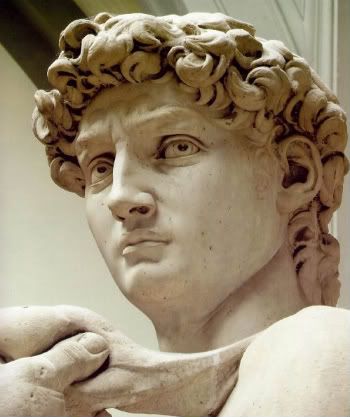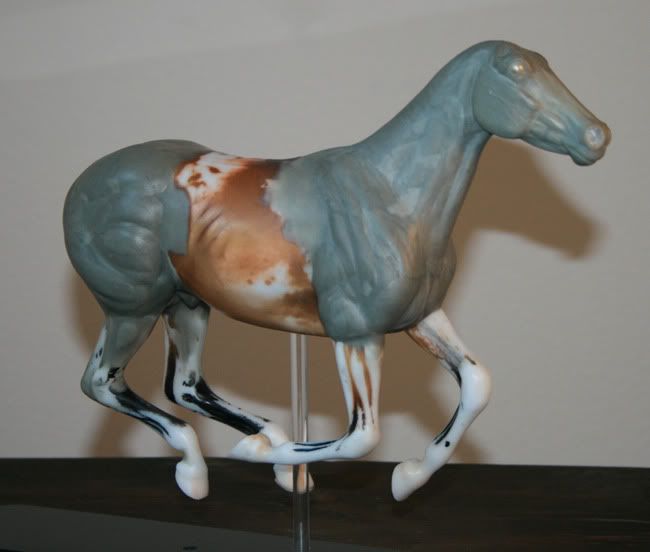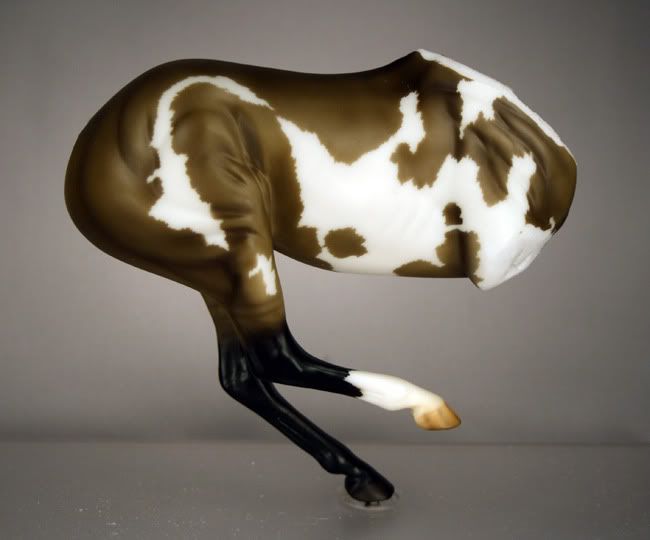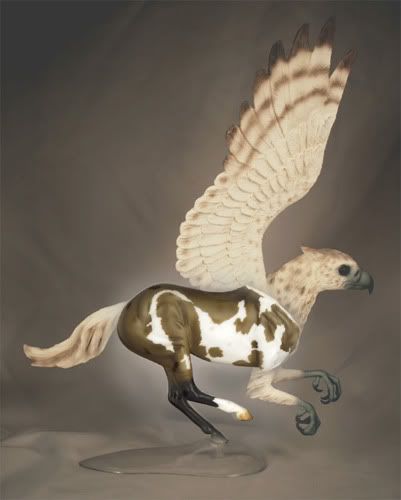Michelangelo liked to talk about how the final piece was already in the marble:
In every block of marble I see a statue as plain as though it stood before me, shaped and perfect in attitude and action. I have only to hew away the rough walls that imprison the lovely apparition to reveal it to the other eyes as mine see it.I work in the opposite direction--I’m generally a builder, not a carver--but the sentiment is the same. As a sculptor, my work mostly lives in my head.
At BreyerWest this year, I got a lot of shocked comments over my jumping pony and Man O War (below, in progress). Both made it through the sculpting, prepping, and painting phase over the course of two weeks, more or less. And I work full time. And I’m training a horse. And I occasionally find the time to sleep.
Well, those two weeks of fury were what the public saw. My reputation for working at a furious pace is--alas--a myth. What you guys didn’t see was the weeks of construction (sawing apart the original plastic bodies and then putting them back together.) Then there were the months of staring them down, not making any visible progress. Then they were shoved out of sight in a box for a few months.
That Man O War? I started him early in 2009. The pony? Almost three years old.
That’s because the second step, the staring bit, is the heart of the progress. I look at a lot of reference photos, but most of the time I just stare at the model. 90% of sculpting for me is mental. I know exactly what I want to do before I jump in. My motto is measure twice, sculpt once.
I guess that’s why I enjoy customs so much. You have *maybe* an hour of working time to get something done, so you need a detailed plan. You can’t (and shouldn’t) wing it on a custom, especially a drastic.
Michaelangelo talked about carving, but as a clay sculptor I build up more than I carve down. I’ve dabbled in carving from time to time, but because I make model horses, I have to build my work instead of whittling it down from a large block. I see the final piece out in space instead in a hunk of marble. I just need to fill in the empty space. Inside the space, I form the armature, build the frame, and apply clay.
Lots of empty space here, but I "see" what I will eventually add.
However, as customizers, we need to learn to work in both directions. I start with more than a block since the original model is (presumably) horse shaped. I carve away what doesn’t fit with my vision of the final product, then I build back what I removed into the empty space.
These bits did not fit my vision for my drastic custom Sham
It’s not particularly exciting to watch me work. I’m slow as snail snot because I spend so much time in my head making edits. I add a little here, remove this bit there…all before I touch my tools. There’s lots of staring. I continue to edit when I build out the frame, usually fixing mistakes I initially made in my head. The frame serves the same purpose as the time I spend in my head as I continue to visualize the model’s surface. The closer I get, the clearer the final product becomes.
What lives in my head.
I devote an enormous amount of time to visualizing because model making is such a objective and technical way to work. To create (or more accurately re-create) a proportional miniature, you need to spend a lot of time analyzing and mentally measuring your work. It’s not abstract art, so you can’t “feel” your way to the final project. Ours is not a touchy-feely profession.
Having said that, while I own a measuring compass, it’s stuffed in a box somewhere in my garage. I’ll use it if I’m really and truly stuck on a problem. I rely on the template I have in my head of what a horse should look like and work to match that. Think of laying one image over another to see where they match and where they differ.
The other side of that coin is I devote significant energy to improving my template. I spend an extended amount of time looking at the real thing (more hours per year then I spend sculpting, by far.) If you want to improve your knowledge of movement and anatomy, find time to spend around live horses. If you don’t own, take lessons, find a friend who does, reach out to local hobbyist who owns, or volunteer at a rescue or therapy center. Invest in a few equine anatomy and breed books and look at every page. Surf the net for images. Look at horses performing different disciplines and familiarize yourself with their varied movement and body types.
Next week I’ll get into the actual nitty-gritty of building a frame.










No comments:
Post a Comment